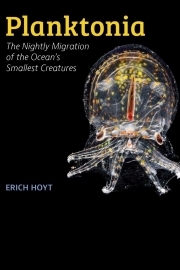Planktonia: The nightly migration of the ocean's smallest creatures

Erich Hoyt
Firefly Books, £27.99
Cetacean researcher and author Erich Hoyt has dedicated this richly illustrated book to a migration that goes largely unseen and unnoticed, yet dwarfs even the biggest mammal or bird migrations on the planet. It is, of course, the nightly vertical migration of plankton from the depths of the ocean up towards the surface to feed, attracting all manner of larger species that sense a late-night feast. Just before dawn, the plankton retreat a thousand or so feet down into the water column to hide in the darkness of the deep ocean, and the visitors to the plankton party disperse – until the same time the next day.
Planktonia begins by defining the many different types of plankton, from the nanoscopic ocean bacteria and viruses to the larger phytoplankton, zooplankton, various floating marine invertebrates and larvae, and, surprisingly to me, ‘megaplankton’, which includes jellyfish, cephalopods and sunfish.
Not all plankton are part of the nightly vertical migration, of course, and the definition of plankton is somewhat woolly, but many different types of floating marine life take the trip up and down in search of sustenance and safety.
The book’s eight chapters are short, the text giving way to hundreds of large and often full-page images of weird and wonderful planktonic creatures, illuminated against the blackness of the ocean. This remarkable collection of images includes scary parasites such as the big-eyed amphipod, magical-looking larvae such as that of the peanut worm, and alien-like translucent forms such as deep sea salps, sea angels, jellyfish and squid. Chapters focus on key locations such as Hawaii, the Gulf Stream and the White Sea, and the stories of the photographers – both academic and amateur – working to observe and capture the nightly migration in these locations.
Later in the book, Hoyt’s writing turns to the importance of protecting these amazing creatures and their nightly ritual. While jellyfish seem to be tolerant to the rising temperatures and acidification of the oceans, other plankton are not, and are either dying out or at the limits of what they can survive. Marine protected areas often do not cover the entire water column down to the seabed, and just 1% of the high seas is protected.
We need a greater appreciation and understanding of these ecosystems if they are to survive – just a little “planktonic love”, as Hoyt puts it. Planktonia should certainly inspire that.
Tom Ireland MRSB


